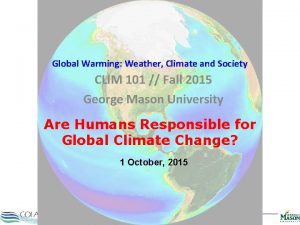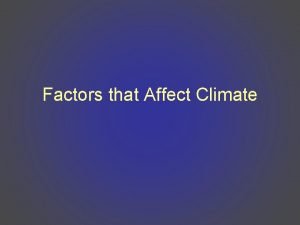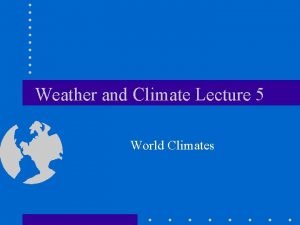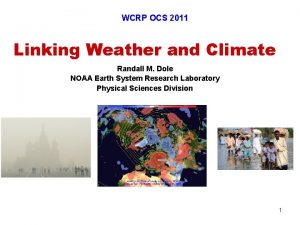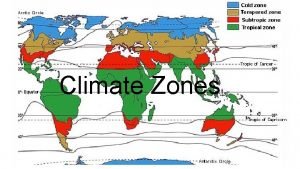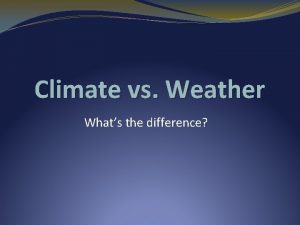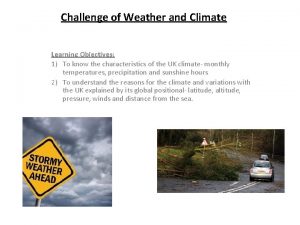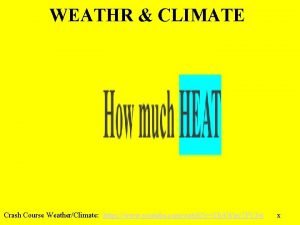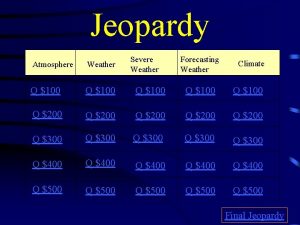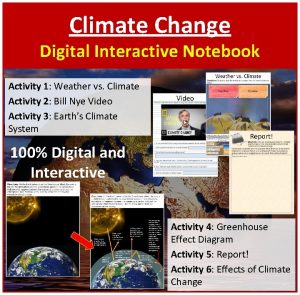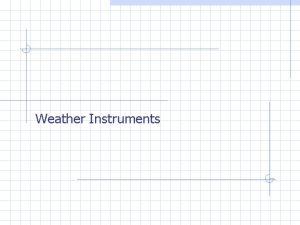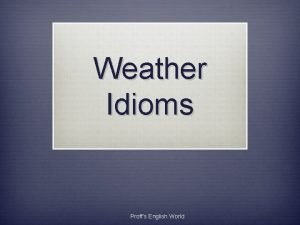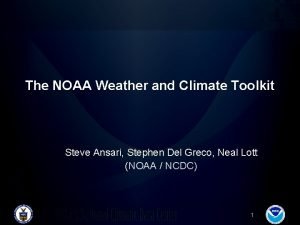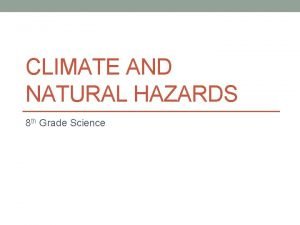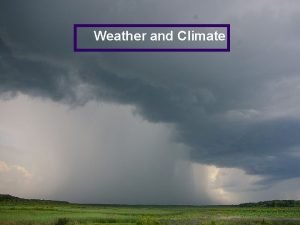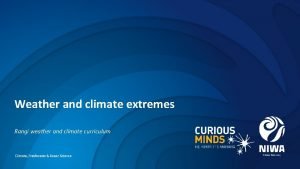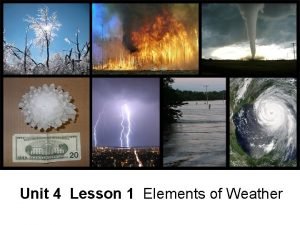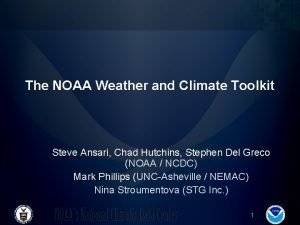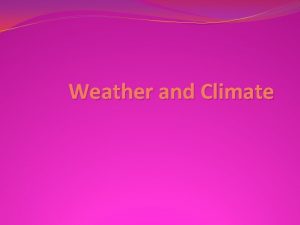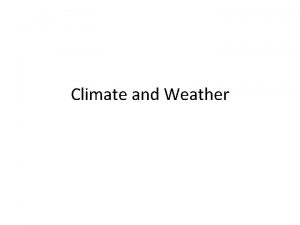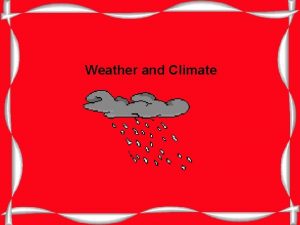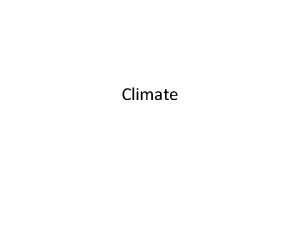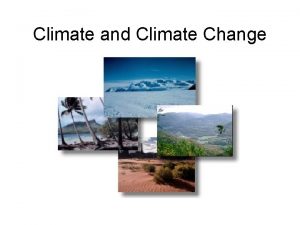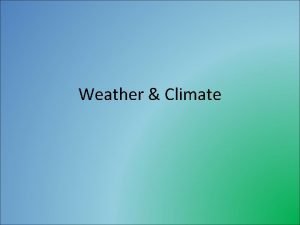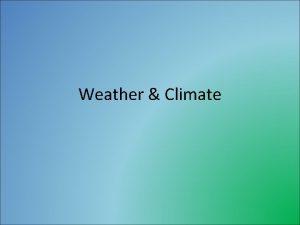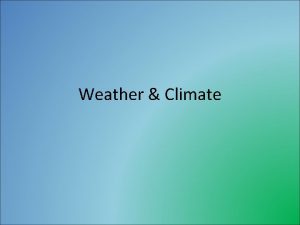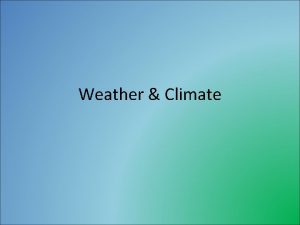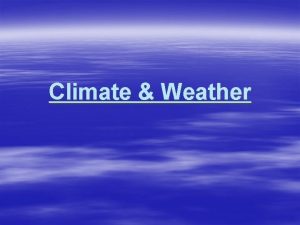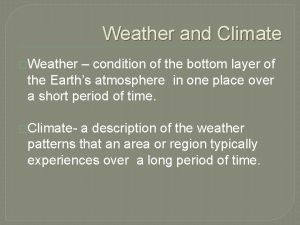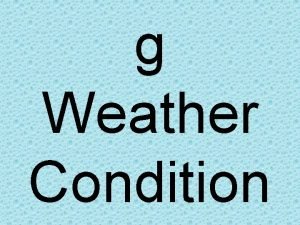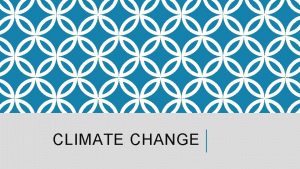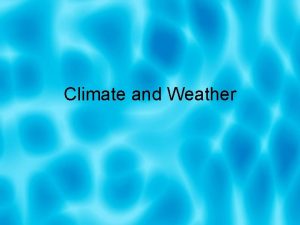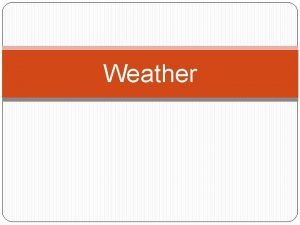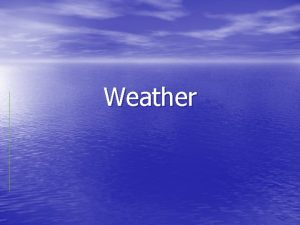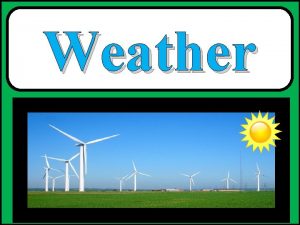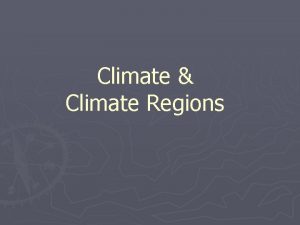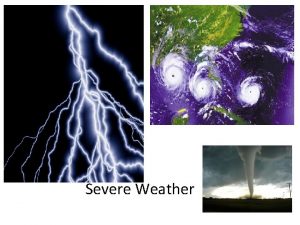Climate and Weather Weather is the condition of























- Slides: 23



Climate and Weather • Weather is the condition of the atmosphere in a certain place at a specific time. • The climate of an area is its long-term typical weather pattern. • The climate of an area is determined by many things; the most important is the earth’s position in relation to the sun. (pages 55– 56) Click the mouse button or press the Space Bar to display the information.

Climate and Weather (cont. ) (pages 55– 56) Click the Speaker button to listen to the audio again.

Climate and Weather (cont. ) Think about your location and the earth’s relationship to the sun. How does the earth-sun relationship affect your life? (pages 55– 56)

Earth’s Revolution • Earth travels in an orbit around the sun, completing one trip about every 365 days. • The seasons are caused by the earth’s revolution around the sun and the earth’s tilt. • The Equator divides Earth into the Northern and Southern Hemispheres. When one hemisphere experiences winter, the other experiences summer. (page 56) Click the mouse button or press the Space Bar to display the information.

Earth’s Revolution (cont. ) How does the reversal of seasons in the Northern and Southern Hemispheres affect the lives of people on Earth? Possible answer: Food crops can be produced year-round because of the reversal of seasons, so fresh fruits and vegetables generally are available all year long. (page 56) Click the mouse button or press the Space Bar to display the answer.

The Poles • The North Pole and the South Pole are located at either end of the earth’s axis. • Each Pole receives continuous indirect sunlight six months each year. • While one receives continuous sunlight, the other receives little to no sunlight. (pages 57– 58) Click the mouse button or press the Space Bar to display the information.

The Greenhouse Effect • Part of the sun’s radiation passes through Earth’s atmosphere. • Like the glass in a greenhouse, the atmosphere keeps the heat from escaping back into space too quickly. • Humans have altered Earth’s atmosphere by burning fuels that release carbon dioxide and other greenhouse gases into the atmosphere. (page 58) Click the mouse button or press the Space Bar to display the information.

The Greenhouse Effect (cont. ) • They also have cut down the forests that absorb carbon dioxide. • Some scientists claim that rising carbon dioxide levels have coincided with a rise in global temperatures. • This trend, known as global warming, is believed to be caused by human activities, such as the burning of coal, oil, and natural gas. (page 58) Click the mouse button or press the Space Bar to display the information.

Latitude and Climate • Low Latitudes The low latitudes are between the Tropic of Cancer and the Tropic of Capricorn. Portions of the low latitudes receive direct sunlight yearround. • High Latitudes The high latitudes are the polar areas. They receive continuous but indirect sunlight for six months each year, and the climate is always cold. (pages 59– 61) Click the mouse button or press the Space Bar to display the information.

Latitude and Climate (cont. ) • Mid-Latitudes The mid-latitudes are the zones between the Tropics and the polar areas. They have a temperate climate ranging from fairly hot to fairly cold, with dramatic seasonal changes. (pages 59– 61)

Elevation and Climate • The higher the altitude of a place, the colder its climate will be. • At high altitudes, the air is thinner and retains less heat. (page 61) Click the mouse button or press the Space Bar to display the information.

Wind and Ocean Currents • Wind Patterns Prevailing winds, global winds that blow in fairly constant patterns, are affected by the direction of the earth’s rotation and latitude. • The trade winds of the tropics blow diagonally toward the Equator. • The westerlies of the mid-latitudes blow diagonally from west to east. • The polar easterlies of the high latitudes blow diagonally from east to west. (pages 61– 63) Click the mouse button or press the Space Bar to display the information.

Wind and Ocean Currents (cont. ) • The Horse Latitudes At the Equator is a narrow, generally windless band called the doldrums. • Just north and south of the Tropics are other narrow bands of calm air. • In the past, wind-powered sailing ships were in danger if they were stranded in these windless areas. • To lighten their vessels in order to take advantage of any breeze, livestock were thrown overboard, which accounts for the name horse latitudes. (pages 61– 63) Click the mouse button or press the Space Bar to display the information.

Wind and Ocean Currents (cont. ) • Ocean Currents Ocean currents move warm and cold water just as winds move warm and cold air. • Weather and the Water Cycle A drop in temperature causes the water vapor in the atmosphere to form clouds and eventually to condense and fall as rain or snow. (pages 61– 63) Click the mouse button or press the Space Bar to display the information.

Wind and Ocean Currents (cont. ) • El Niño A periodic change in the pattern of mid-Pacific ocean currents and water temperatures can cause trade winds to diminish or even change direction, leading to worldwide climate alterations. • This phenomenon is called El Niño. • It has become more frequent and may be linked to global warming. (pages 61– 63) Click the mouse button or press the Space Bar to display the information.

Landforms and Climate • Earth’s surface features, such as mountains and bodies of water, can affect and be affected by climate. • Large bodies of water are slower to heat and cool than land, so bodies of water tend to moderate coastal land temperatures. • When wind meets a mountain range, it is forced upward. (pages 63– 64) Click the mouse button or press the Space Bar to display the information.

Landforms and Climate (cont. ) • This rising air cools and brings precipitation to the windward side (the side facing the wind) of the range. • After the rain falls on the windward side, the air is warmer and drier as it descends on the leeward side (the side facing away from the wind) of the mountain range. • Areas on the leeward sides of mountains receive little precipitation and are often very dry because of this rain shadow effect. (pages 63– 64) Click the mouse button or press the Space Bar to display the information.


Click the mouse button or press the Space Bar to display the answer.

Click the mouse button or press the Space Bar to display the answer.

 Gd&t symbol
Gd&t symbol Climate change 2014 mitigation of climate change
Climate change 2014 mitigation of climate change World geography today
World geography today Weather climate and society
Weather climate and society How does wind affect weather and climate
How does wind affect weather and climate Weather and climate similarities
Weather and climate similarities Conclusion of weather and climate
Conclusion of weather and climate 12 climate zones map
12 climate zones map Whats the difference between weather and climate
Whats the difference between weather and climate Objectives of weather and climate
Objectives of weather and climate Weathr for tomorrow
Weathr for tomorrow Temperate climate zone for kids
Temperate climate zone for kids Weather and climate brainpop
Weather and climate brainpop Weather and climate jeopardy
Weather and climate jeopardy Weather and climate interactive activities
Weather and climate interactive activities Tools used to measure weather
Tools used to measure weather Rains proff
Rains proff We'll weather the weather poem
We'll weather the weather poem Noaa weather and climate toolkit
Noaa weather and climate toolkit Explain how some hail can become baseball sized
Explain how some hail can become baseball sized Stevenson screen unit of measurement
Stevenson screen unit of measurement Kahoot quiz
Kahoot quiz 2 elements of weather
2 elements of weather Noaa weather and climate toolkit
Noaa weather and climate toolkit



